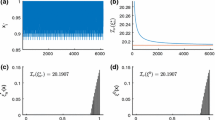Abstract
A fast new algorithm is proposed for numerical computation of (approximate) D-optimal designs. This cocktail algorithm extends the well-known vertex direction method (VDM; Fedorov in Theory of Optimal Experiments, 1972) and the multiplicative algorithm (Silvey et al. in Commun. Stat. Theory Methods 14:1379–1389, 1978), and shares their simplicity and monotonic convergence properties. Numerical examples show that the cocktail algorithm can lead to dramatically improved speed, sometimes by orders of magnitude, relative to either the multiplicative algorithm or the vertex exchange method (a variant of VDM). Key to the improved speed is a new nearest neighbor exchange strategy, which acts locally and complements the global effect of the multiplicative algorithm. Possible extensions to related problems such as nonparametric maximum likelihood estimation are mentioned.
Article PDF
Similar content being viewed by others
Avoid common mistakes on your manuscript.
References
Atkinson, A.C., Chaloner, K., Herzberg, A.M., Juritz, J.: Optimum experimental designs for properties of a compartmental model. Biometrics 49, 325–337 (1993)
Atkinson, A.C., Donev, A.N., Tobias, R.D.: Optimum Experimental Designs, with SAS. Oxford University Press, London (2007)
Atwood, C.L.: Convergent design sequences for sufficiently regular optimality criteria. Ann. Stat. 4, 1124–1138 (1976)
Böhning, D.: A vertex-exchange-method in D-optimal design theory. Metrika 33, 337–347 (1986)
Dette, H., Melas, V.B., Wong, W.K.: Locally D-optimal designs for exponential regression models. Stat. Sin. 16, 789–803 (2006)
Dette, H., Pepelyshev, A., Zhigljavsky, A.: Improving updating rules in multiplicative algorithms for computing D-optimal designs. Comput. Stat. Data Anal. 53, 312–320 (2008)
Fedorov, V.V.: Theory of Optimal Experiments. Academic Press, New York (1972). (Transl. and ed. by W.J. Studden, E.M. Klimko)
Haines, L.M.: A class of equivalent problems in statistics and operational research. S. Afr. Stat. J. 32, 43–66 (1998)
Harman, R., Pronzato, L.: Improvements on removing nonoptimal support points in D-optimum design algorithms. Stat. Probab. Lett. 77, 90–94 (2007)
Jongbloed, G.: The iterative convex minorant algorithm for nonparametric estimation. J. Comput. Graph. Stat. 7, 310–321 (1998)
Kiefer, J.: General equivalence theory for optimum designs (approximate theory). Ann. Stat. 2, 849–879 (1974)
Kiefer, J., Wolfowitz, J.: The equivalence of two extremum problems. Can. J. Math. 12, 363–366 (1960)
Lindsay, B.G.: The geometry of mixture likelihoods: a general theory. Ann. Stat. 11, 86–94 (1983)
Mandal, S., Torsney, B.: Construction of optimal designs using a clustering approach. J. Stat. Plan. Inference 136, 1120–1134 (2006)
Pázman, A.: Foundations of Optimum Experimental Design. Reidel, Dordrecht (1986)
Pukelsheim, F.: Optimal Design of Experiments. Wiley, New York (1993)
Silvey, S.D., Titterington, D.M., Torsney, B.: An algorithm for optimal designs on a finite design space. Commun. Stat. Theory Methods 14, 1379–1389 (1978)
Titterington, D.M.: Algorithms for computing D-optimal design on finite design spaces. In: Proc. of the 1976 Conf. on Information Science and Systems, vol. 3, pp. 213–216. John Hopkins Press, Baltimore (1976)
Titterington, D.M.: Estimation of correlation coefficients by ellipsoidal trimming. Appl. Stat. 27, 227–234 (1978)
Wang, Y.: Dimension-reduced nonparametric maximum likelihood computation for interval-censored data. Comput. Stat. Data Anal. 52, 2388–2402 (2008)
Wellner, J.A., Zhan, Y.: A hybrid algorithm for computation of the nonparametric maximum likelihood estimator from censored data. J. Am. Stat. Assoc. 92, 945–959 (1997)
Wu, C.F.: Some algorithmic aspects of the theory of optimal designs. Ann. Stat. 6, 1286–1301 (1978)
Wynn, H.P.: Results in the theory and construction of D-optimum experimental designs. J. R. Stat. Soc. Ser. B 34, 133–147 (1972)
Yu, Y.: Monotonic convergence of a general algorithm for computing optimal designs. Ann. Stat. 38, 1593–1606 (2010a). arXiv:0905.2646v3
Yu, Y.: Strict monotonicity and convergence rate of Titterington’s algorithm for computing D-optimal designs. Comput. Stat. Data Anal. 54, 1419–1425 (2010b)
Yu, Y.: Improved EM for mixture proportions with applications to nonparametric ML estimation for censored data. Preprint, arXiv:1002.3640 (2010c)
Author information
Authors and Affiliations
Corresponding author
Rights and permissions
Open Access This is an open access article distributed under the terms of the Creative Commons Attribution Noncommercial License (https://creativecommons.org/licenses/by-nc/2.0), which permits any noncommercial use, distribution, and reproduction in any medium, provided the original author(s) and source are credited.
About this article
Cite this article
Yu, Y. D-optimal designs via a cocktail algorithm. Stat Comput 21, 475–481 (2011). https://doi.org/10.1007/s11222-010-9183-2
Received:
Accepted:
Published:
Issue Date:
DOI: https://doi.org/10.1007/s11222-010-9183-2




